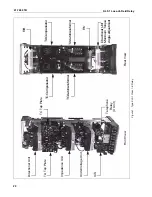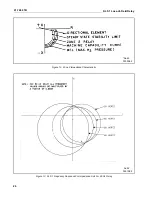
41-748.31B
11
KLF-1 Loss-of-Field Relay
screws may be utilized for grounding the relay. The
electrical connections may be made directly to the
terminals by means of screws for steel panel mount-
ing or the terminal studs furnished with the relay for
thick panel mounting. The terminal studs may be
easily removed or inserted by locking two nuts on the
stud and then turning the proper nut with a wrench.
For detailed FT case information refer to I.L. 41-076.
9.0
ADJUSTMENTS AND
MAINTENANCE -
FOR RELAYS RATED
AT 69 VAC
The proper adjustments to insure correct operation of
this relay have been made at the factory. Upon
receipt of the relay, no customer adjustments,
other than those covered under “SETTINGS’, should
be required.
9.1
ACCEPTANCE CHECK
The following check is recommended to insure that
the relay is in proper working order:
Note:The relay should be energized for at least
one hour.
A. Impedance Unit (Z)
1. Connect the relay as shown in Figure 9
(page 24) with the switch in position 2 and
the trip circuit de-energized.
2.
Make the following tap settings:
T
A
= 11.5
T
C
= 2.55
S
A
= 2
S
C
= 1
M
A
= -.03(R/L)
M
C
= -.09 (R/L)
T
C
link in middle block should be set for +T
C
direction (vertical).
This setting corresponds to Z
A
= 23.7 ohms
and Z
C
= 2.80 ohms.
Adjust the phase shifter for 90° current lag-
ging the voltage.
3.
With the terminal voltage at 50 volts,
increase current until contacts just close.
This current should be within
±
3% of 2.11
amp (2.05 - 2.20 amp).
4.
Adjust phase shifter for 90° current leading
the voltage.
5.
With the terminal voltage at 50 volts increase
current until contacts just close. This current
should be within
±
3% of 17.9 amps, (17.3 -
18.5 amps).
Contact Gap – The gap between the station-
ary contact and moving contact with the
relay in de-energized position should be
approximately .040”.
B. Directional Unit Circuit (D)
1. Connect the relay as shown in Figure 9
(page 24), with the switch in position 1 and
the trip circuit de-energized.
2.
With a terminal voltage of 1 volt and 5
amperes applied, turn the phase shifter to
43° (current leads voltage). The contacts
should be closed. This is the maximum
torque position.
3.
Raise the voltage to 69 volts and vary the
phase shifter to obtain the two angles where
the moving contact just makes with the
left-hand contact. These two angles (where
torque reverses) should be where the current
leads the voltage by 313° and 133°,
(±
4°).
4.
Contact Gap – The gap between the station-
ary contact and moving contact with the relay
in the de-energized position should be
approximately .020”.
C. Undervoltage Circuit
1. Connect the relay as shown in Figure 9, with
switch in position 2 and the trip circuit
de-energized.
2.
Decrease the voltage until the contacts close
to the left. This value should be 53
±
3% volts.
D. Solid State Time Delay Circuit
Block the contacts of the Z unit closed. Apply 125
volts dc with positive at terminal 10 and negative
at terminal 3. Manually close the contacts of the
D unit. Using oscilloscope measure the time
delay by observing the voltage block waveform
between the relay terminal 3 (-) and terminal 1
(+). Operate time should be 0.4 ± .05 seconds.
Close the main relay contacts and pass sufficient
dc current through the trip circuit to close the
contacts of the ICS. This value of current should
not be greater than the particular ICS nameplate
rating. The indicator target should drop freely.












































